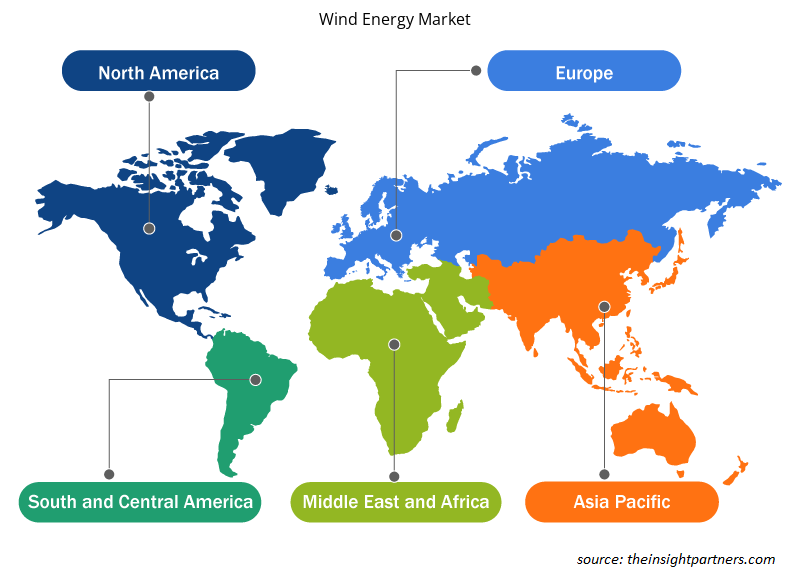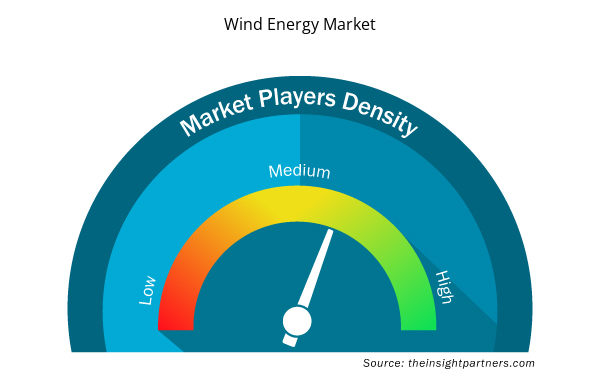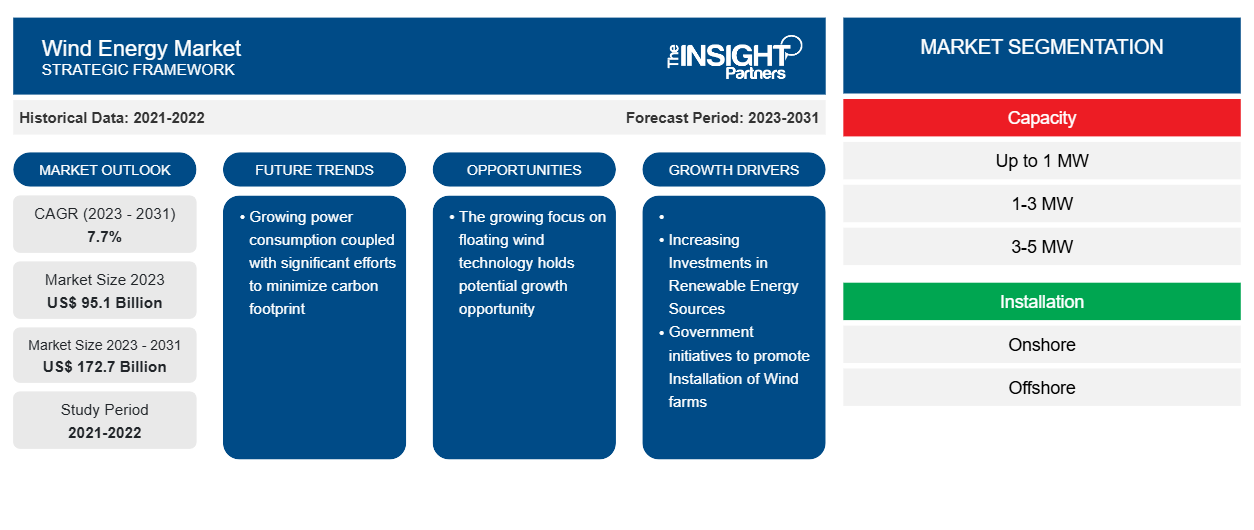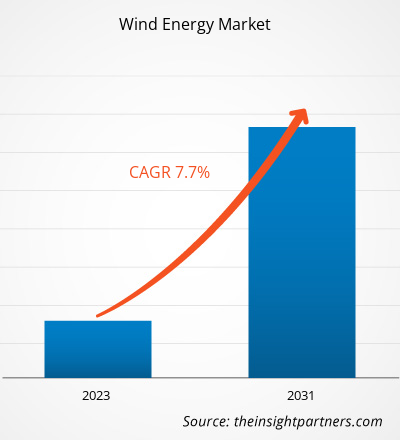风能市场规模预计将从 2023 年的 951 亿美元增至 2031 年的 1727 亿美元。预计 2023-2031 年市场复合年增长率将达到 7.7%。能源消耗的增加以及减少碳排放的巨大努力是推动风能市场发展的关键因素之一。
风能市场分析
由于陆上和海上风电项目数量不断增加,尤其是在偏远地区,预计风能市场将在分析的时间范围内经历显著增长。此外,政府通过专注于利用风能、太阳能、地热能等可再生能源发电来减少碳排放的法规预计将推动 2023 年至 2031 年的市场增长。此外,政府在全球范围内安装风力发电场的举措预计将在未来几年推动市场增长。
风能市场概况
随着人口增长和工业化进程,全球对能源的需求也在上升。能源消耗的增长也推动了发展中国家和发达经济体对可再生能源发电的需求。这推动了全球对风电基础设施的需求。与其他可再生能源相比,风力发电在世界范围内具有很高的重要性和可接受性。风力发电叶片、涡轮机、轴和其他部件的设计和开发技术的先进发展,促进了风能的采用和从可用风能中获得最大功率的重大进步。根据国际可再生能源机构 (IRENA) 的数据,到 2023 年底,全球风电装机容量将从 2021 年的 825 吉瓦达到 1,017 吉瓦。因此,由于风能的优势以及优惠的政策、激励措施和退税,预计未来几年风电装机容量将进一步增加。
定制此报告以满足您的需求
您可以免费定制任何报告,包括本报告的部分内容、国家级分析、Excel 数据包,以及为初创企业和大学提供优惠和折扣
- 获取此报告的关键市场趋势。这个免费样品将包括数据分析,从市场趋势到估计和预测。
风能市场驱动因素和机遇
政府推动风电场安装的举措有望成为风能市场的主要推动力。
预计各国政府在政策、补贴和投资方面对增加风能项目安装的支持将在分析的时间范围内推动风能市场的增长。印度政府正通过私营部门资助在该国推广风力发电厂,提供各种财政和金融激励措施,如加速折旧福利和对风力发电机某些部件的优惠关税或免税。例如,德国正计划提出一项法案来加速风能扩张。新法律将对联邦州的陆上风能扩张实施具有约束力的区域目标。2022 年 4 月,德国计划在一项名为“复活节一揽子计划”的历史性计划的帮助下,从 2025 年开始将海上风电目标部署到每年 10 吉瓦以上,这是德国能源政策最深刻的一系列变化。在这些政府举措的帮助下,到 2030 年,德国 80% 的电力需求将由可再生能源电力满足。
人们对浮动风电技术的日益关注蕴含着潜在的增长机会。
浮动风电技术是将海上风力涡轮机安装在海上浮动结构上,确保涡轮机在深水中发电。浮动或海上风电技术在恶劣的环境条件下效率很高,因此能够产生巨大的电力。这种浮动风电技术在全球多个国家采用,例如中国、德国、日本、英国、法国、比利时和丹麦。浮动风电技术的增长前景主要归因于技术进步、相关优势以及各种服务提供商提供的交钥匙解决方案的增加。各国对实现清洁能源目标的认识不断提高,推动了对浮动海上风电的需求,这为风能市场的增长带来了潜在机会。
浮动海上风电卓越中心报告确定了 22 个最有可能成为新兴可再生能源技术主要参与者的国家。2022 年 1 月,英国政府宣布了 11 个可再生能源项目,每个项目将获得高达 9.5923 亿美元的奖励,并投入 29.7 亿美元来促进英国的可再生能源发电。预计全球对海上或浮动风电技术的此类投资将在未来几年推动市场增长。
风能市场报告细分分析
有助于得出风能市场分析的关键部分是容量和安装。
- 根据容量,风能市场已分为 1 MW 以下、1-3 MW、3-5 MW 和 5 MW 以上。1-3 MW 部分在 2023 年占据了更大的市场份额。
- 根据安装量,风能市场分为陆上和海上。2023 年,陆上部分将占据更大的市场份额。
风能市场份额地域分析
风能市场报告的地理范围主要分为北美、欧洲、亚太、中东和非洲、南美五个区域。
2023 年,亚太地区将主导风能市场。亚太地区包括澳大利亚、中国、日本、印度、韩国和亚太地区其他地区。亚太地区风能行业的增长主要归因于可再生能源行业的投资增加、工业化和城镇化的指数级增长、风能发电能力、新的电气化项目和电网加强计划。根据 IRENA 和中国的可再生能源目标,中国可以在 2021 年至 2030 年期间增加超过 90 吉瓦的新海上风电容量。亚太地区的风能行业将迅速扩张。一项新研究表明,由于国内对海上风电的高需求使中国大陆到 2030 年成为全球最大的市场,该地区本十年的风能行业可能占该地区电力容量组合的近四分之一。
风能市场区域洞察
Insight Partners 的分析师已详细解释了预测期内影响风能市场的区域趋势和因素。本节还讨论了北美、欧洲、亚太地区、中东和非洲以及南美和中美洲的风能市场细分和地理位置。

- 获取风能市场的区域特定数据
风能市场报告范围
| 报告属性 | 细节 |
|---|---|
| 2023 年的市场规模 | 951亿美元 |
| 2031 年市场规模 | 1727亿美元 |
| 全球复合年增长率(2023 - 2031) | 7.7% |
| 史料 | 2021-2022 |
| 预测期 | 2023-2031 |
| 涵盖的领域 | 按容量
|
| 覆盖地区和国家 | 北美
|
| 市场领导者和主要公司简介 |
|
风能市场参与者密度:了解其对商业动态的影响
风能市场正在快速增长,这得益于终端用户需求的不断增长,而这些需求又源于消费者偏好的不断变化、技术进步以及对产品优势的认识不断提高等因素。随着需求的增加,企业正在扩大其产品范围,进行创新以满足消费者需求,并利用新兴趋势,从而进一步推动市场增长。
市场参与者密度是指在特定市场或行业内运营的企业或公司的分布情况。它表明在给定市场空间中,相对于其规模或总市场价值,有多少竞争对手(市场参与者)存在。
在风能市场运营的主要公司有:
- 维斯塔斯风力系统公司
- 西门子能源
- 金风科技
- 远景集团
- GE可再生能源
- 明阳智慧能源
免责声明:上面列出的公司没有按照任何特定顺序排列。

- 了解风能市场顶级关键参与者概况
风能市场新闻及最新发展
风能市场评估是通过收集一手和二手研究后的定性和定量数据进行的,其中包括重要的公司出版物、协会数据和数据库。以下是风能市场的发展和战略列表:
- 2022 年 6 月,维斯塔斯与 PEC Energia 合作在巴西建设一座 86 兆瓦风力发电场。凭借该项目,维斯塔斯自 2018 年以来在巴西的订单量突破了 7 吉瓦的里程碑。
- 2021 年 9 月,风力涡轮机制造商金风科技将其 5 兆瓦陆上测试装置连接到电网,准备在 2022 年开始交付。金风科技的永磁直驱 (PMDD) 陆上 5S 智能风力涡轮机的转子直径为 165 米,轮毂高度从 100 到 130 米不等。
风能市场报告覆盖范围和交付成果
“风能市场规模和预测(2021-2031 年)”报告提供了以下领域的详细风能市场分析:
- 范围内所有主要细分市场的全球、区域和国家层面的市场规模和预测
- 市场动态,如驱动因素、限制因素和关键机遇
- 未来主要趋势
- 详细的波特五力分析
- 全球和区域市场分析涵盖关键市场趋势、主要参与者、法规和最新市场发展
- 行业格局和竞争分析,涵盖市场集中度、热点图分析、知名参与者和最新发展
- 带有 SWOT 分析的详细公司简介
- 历史分析(2 年)、基准年、预测(7 年)及复合年增长率
- PEST 和 SWOT 分析
- 市场规模价值/数量 - 全球、区域、国家
- 行业和竞争格局
- Excel 数据集


- Semiconductor Metrology and Inspection Market
- Photo Printing Market
- Helicopters Market
- Small Internal Combustion Engine Market
- Dairy Flavors Market
- Biopharmaceutical Contract Manufacturing Market
- Hydrocephalus Shunts Market
- Transdermal Drug Delivery System Market
- High Speed Cable Market
- Surety Market

Report Coverage
Revenue forecast, Company Analysis, Industry landscape, Growth factors, and Trends

Segment Covered
This text is related
to segments covered.

Regional Scope
North America, Europe, Asia Pacific, Middle East & Africa, South & Central America

Country Scope
This text is related
to country scope.
Trends and growth analysis reports related to Energy and Power : READ MORE..
The Insight Partners performs research in 4 major stages: Data Collection & Secondary Research, Primary Research, Data Analysis and Data Triangulation & Final Review.
- Data Collection and Secondary Research:
As a market research and consulting firm operating from a decade, we have published and advised several client across the globe. First step for any study will start with an assessment of currently available data and insights from existing reports. Further, historical and current market information is collected from Investor Presentations, Annual Reports, SEC Filings, etc., and other information related to company’s performance and market positioning are gathered from Paid Databases (Factiva, Hoovers, and Reuters) and various other publications available in public domain.
Several associations trade associates, technical forums, institutes, societies and organization are accessed to gain technical as well as market related insights through their publications such as research papers, blogs and press releases related to the studies are referred to get cues about the market. Further, white papers, journals, magazines, and other news articles published in last 3 years are scrutinized and analyzed to understand the current market trends.
- Primary Research:
The primarily interview analysis comprise of data obtained from industry participants interview and answers to survey questions gathered by in-house primary team.
For primary research, interviews are conducted with industry experts/CEOs/Marketing Managers/VPs/Subject Matter Experts from both demand and supply side to get a 360-degree view of the market. The primary team conducts several interviews based on the complexity of the markets to understand the various market trends and dynamics which makes research more credible and precise.
A typical research interview fulfils the following functions:
- Provides first-hand information on the market size, market trends, growth trends, competitive landscape, and outlook
- Validates and strengthens in-house secondary research findings
- Develops the analysis team’s expertise and market understanding
Primary research involves email interactions and telephone interviews for each market, category, segment, and sub-segment across geographies. The participants who typically take part in such a process include, but are not limited to:
- Industry participants: VPs, business development managers, market intelligence managers and national sales managers
- Outside experts: Valuation experts, research analysts and key opinion leaders specializing in the electronics and semiconductor industry.
Below is the breakup of our primary respondents by company, designation, and region:

Once we receive the confirmation from primary research sources or primary respondents, we finalize the base year market estimation and forecast the data as per the macroeconomic and microeconomic factors assessed during data collection.
- Data Analysis:
Once data is validated through both secondary as well as primary respondents, we finalize the market estimations by hypothesis formulation and factor analysis at regional and country level.
- Macro-Economic Factor Analysis:
We analyse macroeconomic indicators such the gross domestic product (GDP), increase in the demand for goods and services across industries, technological advancement, regional economic growth, governmental policies, the influence of COVID-19, PEST analysis, and other aspects. This analysis aids in setting benchmarks for various nations/regions and approximating market splits. Additionally, the general trend of the aforementioned components aid in determining the market's development possibilities.
- Country Level Data:
Various factors that are especially aligned to the country are taken into account to determine the market size for a certain area and country, including the presence of vendors, such as headquarters and offices, the country's GDP, demand patterns, and industry growth. To comprehend the market dynamics for the nation, a number of growth variables, inhibitors, application areas, and current market trends are researched. The aforementioned elements aid in determining the country's overall market's growth potential.
- Company Profile:
The “Table of Contents” is formulated by listing and analyzing more than 25 - 30 companies operating in the market ecosystem across geographies. However, we profile only 10 companies as a standard practice in our syndicate reports. These 10 companies comprise leading, emerging, and regional players. Nonetheless, our analysis is not restricted to the 10 listed companies, we also analyze other companies present in the market to develop a holistic view and understand the prevailing trends. The “Company Profiles” section in the report covers key facts, business description, products & services, financial information, SWOT analysis, and key developments. The financial information presented is extracted from the annual reports and official documents of the publicly listed companies. Upon collecting the information for the sections of respective companies, we verify them via various primary sources and then compile the data in respective company profiles. The company level information helps us in deriving the base number as well as in forecasting the market size.
- Developing Base Number:
Aggregation of sales statistics (2020-2022) and macro-economic factor, and other secondary and primary research insights are utilized to arrive at base number and related market shares for 2022. The data gaps are identified in this step and relevant market data is analyzed, collected from paid primary interviews or databases. On finalizing the base year market size, forecasts are developed on the basis of macro-economic, industry and market growth factors and company level analysis.
- Data Triangulation and Final Review:
The market findings and base year market size calculations are validated from supply as well as demand side. Demand side validations are based on macro-economic factor analysis and benchmarks for respective regions and countries. In case of supply side validations, revenues of major companies are estimated (in case not available) based on industry benchmark, approximate number of employees, product portfolio, and primary interviews revenues are gathered. Further revenue from target product/service segment is assessed to avoid overshooting of market statistics. In case of heavy deviations between supply and demand side values, all thes steps are repeated to achieve synchronization.
We follow an iterative model, wherein we share our research findings with Subject Matter Experts (SME’s) and Key Opinion Leaders (KOLs) until consensus view of the market is not formulated – this model negates any drastic deviation in the opinions of experts. Only validated and universally acceptable research findings are quoted in our reports.
We have important check points that we use to validate our research findings – which we call – data triangulation, where we validate the information, we generate from secondary sources with primary interviews and then we re-validate with our internal data bases and Subject matter experts. This comprehensive model enables us to deliver high quality, reliable data in shortest possible time.


 获取此报告的免费样本
获取此报告的免费样本